Is there an efficient way to unwrap rows in a r data frame to columns? This is an re-occurring problem I run into, when my data I get from an SQL script should be unwrapped into several columns. For example for timeseries forecasting where I don't have an rnn and I instead aim to use standard neural nets. Instead of having recurring nets I plan to flatten the data beforehand so that the net receives the row for t-1, t-2, t-3 etc. See my fancy paint-job below
Basically, for each row I want to concatenate n previous rows on the right, where n depends on how many previous times steps we want to use to predict values in the current row.
Mostly I'm looking for a smart and efficient way of doing it, preferably with existing libraries/functions in r. I can program it in several languages, but aim to find an r solution. I've done this in Java before (which was quite fast) and in r (which took ~forever=1 hour).
Currently I have a bit over 3000 rows and 10 columns. If for example I want to use 15 previous time steps we get 10+15*10 columns. Whether 15 is a good choice I don't know, and therefore I need to be able to quickly test e.g. n= 5, 10, 15, 20, 25, 50.
Edit
To be honest, I'm a beginner when it comes to r, therefore I ask for help instead of yet again coding my custom function for this.
dput gives:
structure(list(Date = structure(c(10L, 9L, 8L, 7L, 6L, 5L, 4L,
3L, 2L, 1L), .Label = c("6/10/2016", "6/13/2016", "6/14/2016",
"6/15/2016", "6/16/2016", "6/17/2016", "6/20/2016", "6/21/2016",
"6/22/2016", "6/23/2016"), class = "factor"), Bid = c(5.04, 4.97,
4.96, 4.93, 4.84, 5.09, 5.05, 4.96, 5.08, 5), Ask = c(5.04, 4.97,
4.96, 4.94, 4.84, 5.09, 5.06, 4.97, 5.08, 5.01), Opening.price = c(4.98,
4.97, 4.95, 4.94, 4.92, 5.01, 5.01, 5.01, 4.95, 5.05), High.price = c(5.07,
4.98, 4.97, 4.99, 4.93, 5.14, 5.06, 5.1, 5.13, 5.09), Low.price = c(4.94,
4.91, 4.89, 4.92, 4.81, 5.01, 4.94, 4.94, 4.89, 4.97), Closing.price = c(5.04,
4.97, 4.95, 4.94, 4.86, 5.08, 5.05, 4.94, 5.06, 4.98), Average.price = c(5.02,
4.96, 4.94, 4.94, 4.87, 5.08, 5.01, 5, 5.01, 5.01), Total.volume = c(18997216L,
17969939L, 21430529L, 20725035L, 66884495L, 32994371L, 24600829L,
24439514L, 26540825L, 24756699L), Turnover = c(95382241.29, 89106913.2,
105823382.96, 102379207.58, 325592595.95, 167697936.93, 123243137.11,
122189815.88, 133063486.77, 124080799.95), Trades = c(9220L,
9317L, 10075L, 10230L, 16446L, 13544L, 11888L, 10923L, 11981L,
9696L)), .Names = c("Date", "Bid", "Ask", "Opening.price", "High.price",
"Low.price", "Closing.price", "Average.price", "Total.volume",
"Turnover", "Trades"), class = "data.frame", row.names = c(NA,
-10L))
The result when n = 2 (append 2 previous timesteps on the right):
structure(list(Date = structure(c(8L, 7L, 6L, 5L, 4L, 3L, 2L,
1L), .Label = c("6/14/2016", "6/15/2016", "6/16/2016", "6/17/2016",
"6/20/2016", "6/21/2016", "6/22/2016", "6/23/2016"), class = "factor"),
Bid = c(5.04, 4.97, 4.96, 4.93, 4.84, 5.09, 5.05, 4.96),
Ask = c(5.04, 4.97, 4.96, 4.94, 4.84, 5.09, 5.06, 4.97),
Opening.price = c(4.98, 4.97, 4.95, 4.94, 4.92, 5.01, 5.01,
5.01), High.price = c(5.07, 4.98, 4.97, 4.99, 4.93, 5.14,
5.06, 5.1), Low.price = c(4.94, 4.91, 4.89, 4.92, 4.81, 5.01,
4.94, 4.94), Closing.price = c(5.04, 4.97, 4.95, 4.94, 4.86,
5.08, 5.05, 4.94), Average.price = c(5.02, 4.96, 4.94, 4.94,
4.87, 5.08, 5.01, 5), Total.volume = c(18997216L, 17969939L,
21430529L, 20725035L, 66884495L, 32994371L, 24600829L, 24439514L
), Turnover = c(95382241.29, 89106913.2, 105823382.96, 102379207.58,
325592595.95, 167697936.93, 123243137.11, 122189815.88),
Trades = c(9220L, 9317L, 10075L, 10230L, 16446L, 13544L,
11888L, 10923L), X1_Bid = c(4.97, 4.96, 4.93, 4.84, 5.09,
5.05, 4.96, 5.08), X1_Ask = c(4.97, 4.96, 4.94, 4.84, 5.09,
5.06, 4.97, 5.08), X1_Opening.price = c(4.97, 4.95, 4.94,
4.92, 5.01, 5.01, 5.01, 4.95), X1_High.price = c(4.98, 4.97,
4.99, 4.93, 5.14, 5.06, 5.1, 5.13), X1_Low.price = c(4.91,
4.89, 4.92, 4.81, 5.01, 4.94, 4.94, 4.89), X1_Closing.price = c(4.97,
4.95, 4.94, 4.86, 5.08, 5.05, 4.94, 5.06), X1_Average.price = c(4.96,
4.94, 4.94, 4.87, 5.08, 5.01, 5, 5.01), X1_Total.volume = c(17969939L,
21430529L, 20725035L, 66884495L, 32994371L, 24600829L, 24439514L,
26540825L), X1_Turnover = c(89106913.2, 105823382.96, 102379207.58,
325592595.95, 167697936.93, 123243137.11, 122189815.88, 133063486.77
), X1_Trades = c(9317L, 10075L, 10230L, 16446L, 13544L, 11888L,
10923L, 11981L), X2_Bid = c(4.96, 4.93, 4.84, 5.09, 5.05,
4.96, 5.08, 5), X2_Ask = c(4.96, 4.94, 4.84, 5.09, 5.06,
4.97, 5.08, 5.01), X2_Opening.price = c(4.95, 4.94, 4.92,
5.01, 5.01, 5.01, 4.95, 5.05), X2_High.price = c(4.97, 4.99,
4.93, 5.14, 5.06, 5.1, 5.13, 5.09), X2_Low.price = c(4.89,
4.92, 4.81, 5.01, 4.94, 4.94, 4.89, 4.97), X2_Closing.price = c(4.95,
4.94, 4.86, 5.08, 5.05, 4.94, 5.06, 4.98), X2_Average.price = c(4.94,
4.94, 4.87, 5.08, 5.01, 5, 5.01, 5.01), X2_Total.volume = c(21430529L,
20725035L, 66884495L, 32994371L, 24600829L, 24439514L, 26540825L,
24756699L), X2_Turnover = c(105823382.96, 102379207.58, 325592595.95,
167697936.93, 123243137.11, 122189815.88, 133063486.77, 124080799.95
), X2_Trades = c(10075L, 10230L, 16446L, 13544L, 11888L,
10923L, 11981L, 9696L)), .Names = c("Date", "Bid", "Ask",
"Opening.price", "High.price", "Low.price", "Closing.price",
"Average.price", "Total.volume", "Turnover", "Trades", "X1_Bid",
"X1_Ask", "X1_Opening.price", "X1_High.price", "X1_Low.price",
"X1_Closing.price", "X1_Average.price", "X1_Total.volume", "X1_Turnover",
"X1_Trades", "X2_Bid", "X2_Ask", "X2_Opening.price", "X2_High.price",
"X2_Low.price", "X2_Closing.price", "X2_Average.price", "X2_Total.volume",
"X2_Turnover", "X2_Trades"), class = "data.frame", row.names = c(NA,
-8L))
edit 2
Here's somebody who's haven a question about rnns and how they are different from classic nets when the previous time points are input directly. rnn vs classic net Part 1 of the question explains how I want to get x(t-1), x(t-2)... on the right of the data I want to predict, for each row.
